Vučitrn
| Vučitrn | |
|---|---|
| Municipality and city | |
| Vushtrria Vushtrri | |
|
Vushtrri during the day | |
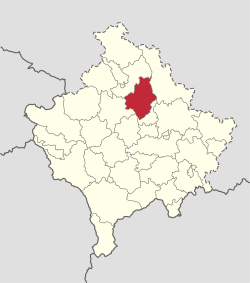 Location of municipality of Vučitrn | |
| Coordinates: 42°49′N 20°58′E / 42.817°N 20.967°ECoordinates: 42°49′N 20°58′E / 42.817°N 20.967°E | |
| Country | Kosovo[lower-alpha 1] |
| District | District of Mitrovica |
| Government | |
| • Mayor | Bajram Mulaku (PDK) |
| Area | |
| • Total | 345 km2 (133 sq mi) |
| Elevation | 944 m (3,097 ft) |
| Highest elevation | 1,380 m (4,530 ft) |
| Lowest elevation | 508 m (1,667 ft) |
| Population (2011) | |
| • Total | 69,870 |
| • Density | 202/km2 (520/sq mi) |
| Time zone | CET (UTC+1) |
| • Summer (DST) | CEST (UTC+2) |
| Postal code | 42000 |
| Area code(s) | +381 28 |
| Car plates | 02 |
| Website | Municipality of Vučitrn |
Vučitrn or Vushtrri (Albanian: Vushtrri or Vushtrria; Serbian: Вучитрн, Vučitrn, pronounced [ʋǔtʃitr̩ːn]; Turkish: Vıçıtırın) is a city located in the north part of the Kosovo.[lower-alpha 1] With a total population of 69,870 the municipality of Vučitrn is the 9th largest municipality in Kosovo by population. It has a total area of 345 km2, and the density of population is 202/km2. This area covered by Vučitrn takes approximately 3.2% of the total territory of Kosovo. Vučitrn is surrounded with the city of Mitrovica in north, Podujevo (Besiana) in east, Obilić (Kastriot) in south, Glogovac (Drenas or Gllogovc) in south-west, and with Skenderaj in west. The municipality of Vučitrn has 67 villages.
Vučitrn is an antique locality dating since the time of Illyrian Empire, respectively the Kingdom of Dardania who lived in the territory of Kosovo in the 4th century BC. The Illyrian name of Vučitrn was Viciana which means “The side of calves” (Ana e Viqave). When the Roman Empire invaded the Kingdom of Dardania in the 1st century BC, the Romans added the Latin suffix ‘um’ to the name of Viciana, and therefore it became Vicianum. In Serbian language, Vučitrn is the name of the plant Ononis spinosa, which is abundant in the region.[1][2] In the documents of Ottoman Empire, which conquered the area in the 14th century, we find the name of Vučitrn as Viҫitrine, that has a meaning of “Calves’ fence” (Trina e viҫave).
The cultural and historic monuments left as the city’s heritage, is the main characteristic of the city. The Castle, Stone Bridge, Public Bath and Cesme were built centuries ago and are the biggest attractions of the city.
Vučitrn is an important economic centre, mostly known as the biggest producer of potato in Kosovo. Known as the centre of many factories and important companies of Kosovo, such as: Vipa, GalvaSteel Llamkos, Binni and Berto.
History
Prehistory and Roman period
The Dardani tribe ruled the region in the Iron Age, until the Roman conquest in the 1st century AD. The Roman town of Viciana lied in a wider area than Vučitrn today. The religion was polytheist and the main enterprises were farming, agriculture, etc. The Romans developed road networks, two of whom crossed Viciana, the Naissus-Lissus (northeast-southwest) and a road that connected Bosnia with Skopje (northwest-southeast). Archaeological sites exist at Samadrexha, Gjyteza, Gjyteti, Pestova, Breglumi, etc.
Medieval
After the separation of Roman Empire, Illyria were under the administration of the East (Byzantine) Empire. During the Early Middle Ages, the region was settled with Slavs. In the first half of the 14th century Vučitrn was a capital of the lands of Branković dynasty (Vuk and Đurađ Branković). Despot Đurađ Branković issued charters from Vučitrn. From that period there are runis of Vojinovića Tower and great stone bridge. After the battle of Kosovo, Ottoman officers were subsequently stationed in Vučitrn. Ragusan colonies were established during the 14th and 15th centuries.
Ottoman

In Ottoman documents, the town was known as Vıçıtırın, and it was established as the seat of the sanjak of Vıçıtırın. The sanjak was one of the more important European holdings due to the high concentration of ore. It served as a larger military and commercial center the fall of the Ottoman Empire.
Modern
In the end of the 18th century, Vučitrn started to lose its importance because of the Austro-Hungarian wars, the migration, internal economic crisis and the development of other regional centers. From 1877 to 1913, Vučitrn was part of the Kosovo Vilayet of the Ottoman Empire. Vučitrn gave a great contribution in the general rebellions of 1910-1912. Hasan Prishtina was the greatest intellectual man of the time, who’s patriotic activity was the key to development of education and economy in the Albanian territories. In 1912, the Serbian army invaded Vučitrn. On 10 August 1913, the Treaty of Bucharest made Vučitrn part of the Kingdom of Serbia. The 1920s were characterized with the rebels activity. Azem Bejta and Shote Galica were the main activists of the time. From 1929 to 1941, Vučitrn was part of the Morava Banovina of the Kingdom of Yugoslavia.
Kosovo War
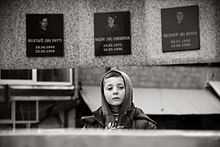
During 1998-1999,the Kosovo Liberation Army started to organize the war against forces of the Federal Republic of Yugoslavia. The mobilization started in the villages of Strofc, Pantine, Ceceli, Galice, Bequk, Gjytet, etc. During the fights against the Serbian army, many KLA soldiers were killed, and many civilians were murdered. The Serbians did many massacres in the municipality of Vučitrn : The massacre in Reznik – 6 April 1999 The massacre in Martirak – 2 May 1999, when nearly 116 people were murdered. The massacre in the city of Vučitrn – 24 May 1999 More than 500 people were killed during the war in Vučitrn, and more than 108 people went missing without a trace. NATO forces entered Vučitrn in 16 June 1999, which is the date of the Vučitrn's liberty.
Geography
Vučitrn is located in the north-east of Kosovo. With a total area of 345 km2, its maximum length is 34 km north-south and maximum width about 23 km east-west. The municipality’s border line includes nearly 104.5 km. Vučitrn is surrounded with the city of Mitrovica in north, Podujeva (Besiana) in east, Obiliq (Kastriot) in south, Drenas (Gllogovc) in south-west, and with Skenderaj in west. The municipality of Vučitrn has 67 villages. This area covered by Vučitrn takes approximately 3.2% of the total territory of the Republic of Kosovo. Vučitrn has a very favorable geographical position because it lays in the northern part of “Rrafshi i Kosoves” (one of the two regional flat units of Kosovo), where the antiquity and medieval transport routes met, which had an important role in creating and developing the city and the region. The two most important antique routes in Kosovo were: north-east to south-west, respectively Naissus-Lissus road (Nis-Lezha); and north-west to south-east, road that connected Bosnia and Macedonia. It is said that these to routes passed by Vučitrn, and had a very important influence in developing the region of Mitrovica. Nowadays, Prishtina-Mitrovica highway passes through Vučitrn, and links the north region of Kosovo with the east and central part of the country.
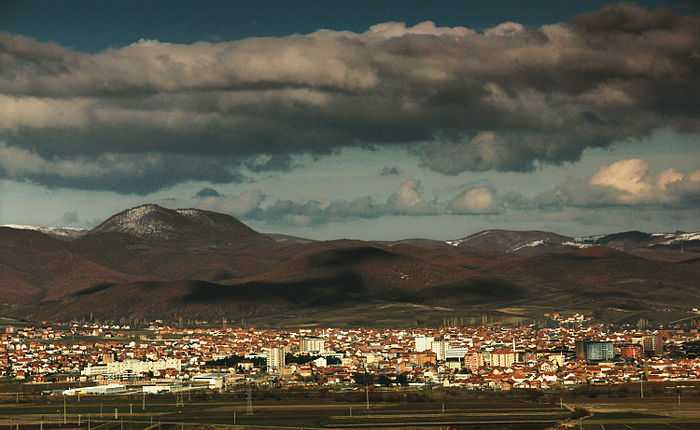
Topography
In general, the territory of Vučitrn has a hilly land relief. Based on morphological characteristics, in the territory of Vučitrn there are three relief compounds: valley, hilly and mountains. The lowest point of Vučitrn's relief is 508 meters near the place when river Smrekonica flows into Sitnica river. The highest point in the territory of Vučitrn is 1380 meters in “Maja e Zeze” peak, in the south of Bare village. The valley territories are represented by alluvial space of Sitnica river, which lies from north to south, reaching its maximum width before the merger of Sitnica and Llapi river. The hilly relief is mostly seen in the east and west side of municipality. The mountains in Vučitrn can be seen in the south part of Kopaonik and east side of Qyqavica. Qyqavica Mountains lies in the western side of the city, with its highest point of 1091 meters. These mountains are a natural border between two big valleys, known as “Rrafshi i Kosoves” and “Fushegropa e Drenices”.
Waters
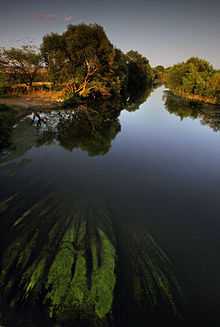
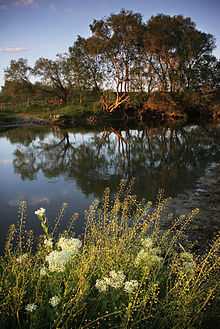
In the territory of Vučitrn flows the biggest river in the city, Sitnica. It is the second biggest natural basin river of Kosovo with 2912 km2, after Drini i Bardhe (4313 km2). According to many years of hydro-metrical observation, river Sitnica brings approximately 13.94 m3/s of water, or 439.11 million m³ of water per year. The Sitnica river gathers smaller rivers such as Llapi, Lumkuqi, Terrstena, Banja e Gjytezes and some other water flows that comes from the east side of Qyqavica Mountain. Now Sitnica river is in 4th category of pollution, category which includes the most polluted rivers in Kosova. Besides chemical pollution, Sitnica river is also contaminated by KEDS’s phenol, industrial and urban water.
Through the city it also flows river Terrstena whose spring is in the south-west of Kopaonik Mountains. Vučitrn is provided with water from “Iber-Lepenc” hydro system. Around 84% of households residing in Vučitrn report to be connected to the public water provider - water is piped into their dwelling or compound - compared to Kosovo’s average of 60% of households. The remaining households have access to safe drinking water through public taps (1%), protected wells (1%), and protected springs (3%), while 4% use bottled water. Eight percent of households in Vučitrn (compared to Kosovo’s average of 9%) do not have access to safe drinking water as they get it from tube wells or boreholes [3]
Climate
Based on geographical position, Kosovo has Mediterranean-Continental climate and European- Continental climate. Vučitrn is characterized with cold winters and hot summers. The city doesn't have any climate station with full data and observations of meteorological conditions, so the main information comes from the nearest stations, Mitrovica and Prishtina. Vučitrn has nearly 2,140 hours of insolation during the year.
According to monthly average of temperature, the highest temperature rates are in months of July and August (20˚C), while the lowest rates are in January (-1˚C). The annual average temperature is about 10.1˚C.
The annual average rate of air humidity is 77.2%. Atmospheric precipitation of the year in Vučitrn, is about 646 mm.
Natural Resources
Vučitrn is rich in natural resources, especially minerals, wood and stone, especially in the areas below:
- Duboc: Magnesite and Porcelain
- Bivolak, Zhilivodë, Beçuk, Stroc, Gllvotin – wood coal
- Pasomë, Tërllobuq, Smrekonicë dhe Shalë – exploitation of stone
- Gumnishtë and Boshlan – lead and zinc ore
- Bajnskë – thermal and mineral water
- Gjelbishtë and Gojbulë – mineral water
- Karaçë – mineral sources[4]
Demographics
Vučitrn is one of the oldest localities in Kosovo. Territory of municipality was located in the north part of Dardania. The Roman Invasion founded this area well-organized economically and politically. Data about this settlement was given by a large number of historians. One of them was the famous Ottoman traveler Evliya Çelebi. In his book of travels in 1662, he quotes: “…Vucitern was invaded in 792 by Gazi Hodovendiqar, who destroyed the fortress. Vucitern is the centre of Sanjak of Vucitern, depended by Eyalet of Rumelia…..The residents of Vucitern are a nation of Rumelia. They speak Albanian language and Turkish. I never heard them speak Bosnian language…”.
The municipality of Vučitrn has 67 villages. The total number of residents of Vučitrn Municipality is 69,870.
27,272 people live in urban areas, while 42,598 live in rural areas. The density of population is 202/km2. According to Kosovo Agency of Statistics, the number of children born in Vučitrn after 2005, is 6504 babies. Vučitrn is characterized with young population, high level of birthrate, and with local, regional and external migration.
Demographic data by municipality, Kosovo Agency of Statistics
| Total number of population | Age-groups | ||
|---|---|---|---|
| 0-24 | 24-26 | Over 65 | |
| 69,870 | 33,326 | 32,036 | 4508 |
| Total number of population | Albanian | Serbian | Turkish | Bosnian | Roma | Ashkali | Egyptian | Gorani | Others |
|---|---|---|---|---|---|---|---|---|---|
| 69,870 | 68,840 | 384 | 278 | 33 | 68 | 143 | 1 | 3 | 120 |
In Vučitrn there are 11,866 households. 4890 of them are located in urban zone, and a number of 6976 are in rural areas. Average number of persons per household is 5.9 people.
According to the statistics, in Vučitrn there are 13,740 buildings. The number of occupied houses is 11,650.
Resident population by first and second source of livelihood in the municipality of Vučitrn, Socio-Economic data by municipality, Kosovo Agency of Statistics.
| First source of livelihood | ||||||||
|---|---|---|---|---|---|---|---|---|
| Work (including work in own land, work in own business or family business) | Property, investments(rent of a real estate, financial interests | Pensions | Social assistance | Other assistance(unemployment benefits, sickness and maternity allowances, scholarship) | Transfer of money from abroad | Support by other persons(Excuding remittances | Other sources | |
| Total | 16486 | 303 | 5346 | 4902 | 274 | 1903 | 34663 | 5993 |
| Urban | 6591 | 181 | 2203 | 1698 | 82 | 831 | 13726 | 1960 |
| Rural | 9895 | 122 | 3143 | 3204 | 192 | 1072 | 20937 | 4033 |
| Second source of livelihood | ||||||||
|---|---|---|---|---|---|---|---|---|
| Work (including work in own land, work in own business or family business) | Property, investments(rent of a real estate, financial interests | Pensions | Social assistance | Other assistance(unemployment benefits, sickness and maternity allowances, scholarship) | Transfer of money from abroad | Support by other persons(Excuding remittances | Other sources | |
| Total | 688 | 338 | 1031 | 556 | 32 | 1668 | 3960 | 17598 |
| Urban | 252 | 265 | 580 | 113 | 12 | 547 | 1439 | 3791 |
| Rural | 436 | 73 | 451 | 443 | 20 | 1121 | 2521 | 13807 |
Cultural Heritage
Old City Fortress – the Monument was built in the center of the old city, which remains in the city center. The Old Fortress in Vučitrn was built in the Justinian I period (527-565). It served as an inn during the medieval period as well as the Ottoman Empire era. It has a surface area of 1,100 m2, and the pyrgus has a surface area of 100 m2. Its walls are 10–12 m high and 3–4 meters thick.
The Old Stone Bridge – This monument was built between the late antiquity and early medieval periods. The bridge is located in the northwestern part of the old city. It is 135 meters long and six meters wide and has nine arches. However, based on the legends it had 12 arches which were later covered. The Stone Bridge was built over the Sitnica River, but the river has since changed its course by several hundred meters to the west.
The Hammam (Public Bath) in Vučitrn was built in the northwestern part of the old city. This public bath was built in the 15th century by Gazi Ali Beu. It is one of the oldest hammams in the Balkans, and was used until the Second World War. It served as a public bath for both men and women, who used the hammam on different days. These monuments are under state protection.
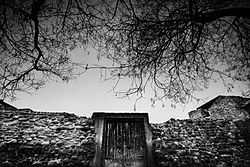 Castle of Vučitrn |
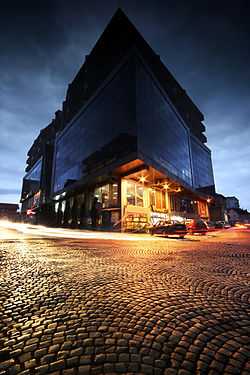 Cobbled road |
Cityscape
 Vučitrn during daylight |
 Vučitrn during the night |
Government
| Name of the party | Votes | Percentage | Seats |
|---|---|---|---|
| Democratic Party of Kosovo (Partia Demokratike e Kosovës) | 9,641 | 34,64% | 12 |
| Democratic League of Kosovo (Lidhja Demokratike e Kosovës) | 5,418 | 19,47% | 7 |
| Alliance for the Future of Kosovo (Aleanca për Ardhmërinë e Kosovës) coalition with Democratic League of Dardania (Lidhja Demokratike e Dardanisë) | 5,084 | 18,27% | 6 |
| Vetëvendosje! (Vetëvendosje!) | 2,837 | 10,19% | 3 |
| Justice Party (Kosovo) (Partia e Drejtësisë) | 1,324 | 4,76% | 2 |
| New Kosovo Alliance (Koalicioni për Kosovë të Re) | 1,263 | 4,54% | 2 |
| Serb List (Kosovo) (Lista Serbe) | 538 | 1,93% | 1 |
| Movement for Unification (Lëvizja për Bashkim) | 520 | 1,87% | 1 |
| Turkish Democratic Party of Kosovo (Kosova Demokratik Türk Partisi) | 492 | 1,77% | 1 |
The mayor of Vučitrn municipality is Bajram Mulaku from the biggest political subject in Vučitrn, PDK (Kosova Democratic Party), elected by the citizens in the 2013 local elections for the third time in a row. The municipality assembly consists of 35 members of 8 different political subjects, and its chairman is Shpetim Zhegrova. The executive of Vučitrn municipality consists of 12 departments.
According to Medium-term Budgetary Framework 2014-2016, the municipality of Vučitrn has planned a significant increase of the budget in the next three years. Comparing to 2013 where the municipality budget was about 12.6 million euro, in the 2014 the budget will be approximately 13.4 million euro. The government grant will be 11.7 million euro, while the own source revenues 1.6 million euro.[5]
Performance of the Public Administration
Thirty-five percent of Vučitrn respondents reported that they had visited the municipal office during the last 12 months to request a document (e.g. birth certificate, building permit, and such) or a service. A slightly higher share than Kosovo’s average, 84% compared to 82%, reported that their request was fulfilled, whereas 6% reported that they were only sometimes provided with the requested document or service. Higher percentages of Vučitrn residents compared to Kosovo’s averages think that the Public Administration is efficient or very efficient in issuing all of the following documents: passports (87%), ID cards (90%), vehicle registration documents (79%), driver’s licenses (84%), building permits (73%), business licenses (70%), marriage, birth, and death certificates (87%), and Social Assistance cards (69%).
Satisfaction with local authorities
KMS 2012 data show that the share of Vučitrn residents who are satisfied with the work of their Mayor, Municipal Assembly, and Municipal Administration is lower than Kosovo’s average. Sixty-seven percent of Vučitrn residents compared to 69% of Kosovans on average are satisfied with the work of their Mayor, 49% compared to 63% of Kosovans on average are satisfied with the work of their Municipal Assembly, and 45% compared to 64% of Kosovans on average are satisfied with the work of the Municipal Administration. A relatively high share (65%) of Vučitrn residents believes that their local authorities have the capacity to solve the problems in their municipality. The share of those who believe that only the central government can solve these problems is equal to Kosovo’s average of 15%.
Satisfaction with public services
The satisfaction level of Vučitrn 's residents with local authorities is slightly higher than Kosovo’s average. While their satisfaction level is significantly lower for most of the public goods and services, the residents of Vučitrn are more satisfied with public procurement and tenders, protection of cultural heritage, nature and species conservation, management of public spaces (availability and usability of parks and squares, street lighting, and environmental protection), public parking (safety, availability, signage, and location) and sidewalks (availability, usability, and condition) compared to Kosovo’s averages.
The residents of Vučitrn are mostly satisfied with access and quality of education in preschools, primary schools, and secondary schools, emergency services (firefighting and medical emergency services), and Kosovo Police.
The lowest satisfaction level has been recorded for electricity supply, supply of medicines and medical supplies in hospitals and family medical centers, and cultural, youth, and sports activities.[3]
Economy
Vučitrn is a city with a sustainable economic development, thanks to qualitative arable land that offers favorable conditions of cultivating many agricultural crops. Vučitrn is the leader in production of potato in Kosovo.
In Vučitrn there are 2641 registered businesses. Most of these businesses are oriented in commercial activity. Based on official data of Ministry of Trade and Industry, nearly 45.36% of businesses are engaged in commerce, 19% of them in transportation and telecommunication, 9% are businesses who offers different services like hotels, restaurants, etc.
| Economy activities | Nr. of businesses | Percentage | |
|---|---|---|---|
| 1 | Agriculture, hunting, forestry and fishing | 58 | 2.20% |
| 2 | Mining industry | 3 | 0.11% |
| 3 | Manufacturing industry | 201 | 7.61% |
| 4 | Production of electricity, gas, water, steam, hot water and construction | 117 | 4.43% |
| 5 | Wholesale and retail market, technical services | 1198 | 45.36% |
| 6 | Hotels and restaurants | 234 | 8.86% |
| 7 | Transport, warehouse and telecommunication | 498 | 18.86% |
| 8 | Real estate | 75 | 2.84% |
| 9 | Education, healthcare and welfare | 116 | 4.39% |
| 10 | Other social activities | 141 | 5.34% |
| Total | 2641 | 100 % | |
Retail activity is concentrated mainly in the city center, on the roads “Deshmoret e Kombit "and “Skenderbeu", while major markets are scattered on the outskirts of town, on the highway Vučitrn - Pristina. Hotels, bars, fast foods are mainly concentrated in the centre of the city, respectively in the “Sheshi i lirise” and “Adem Jashari” streets. With the drafting of the Municipal Development Plan (2009 - 2014+), it is provided that both sides of the highway are places where the businesses can be developed at a distance of 100 m. Also with the Municipal Development Plan, it is planned the construction of an industrial area in a place called Lumadh, in an area of 14.86 hectares where 1,600,000 euros will be invested along with donors, to complete infrastructure for the area, which will help to create optimal conditions for conducting business activities especially in the field of manufacturing activity etc.
Business Zones
The Vučitrn municipal assembly, during its session on March 27, 2008 decided to create an Industrial Zone of common interest in the cadastral zones of Banjskë, Tarazhë, Bukosh and Gracë.
- Taraxhë - pasture land, surface area of 04.84.18 ha;
- Bukosh - pasture land, surface area of 17.98.87 ha.
- Gracë - arable land, at the site called “Utrinë”, total surface area of 24.48.70 ha.
- Banjskë - split in parcels, surface area of 76, 86.60 ha and the rest total area is 10, 65.88 ha.
Vučitrn municipal assembly is also in the process of taking a decision to create a Business Zone in Lumadh village. While the land quality is poor, the surface area is estimated at 14.86 ha, and is owned by the municipality. The designated site for the Business Park is Lumadh-Vučitrn. The project was developed and submitted to the Ministry of Trade and Industry.
The municipality of Vučitrn lies between two regional centers, Pristina and Mitrovica. This advantage enables an easy access in these two big markets. According to the municipality’s official data, the number of employed people in specific sectors is:
Number of employees in the municipality’s administration
| Administration | 231 |
| Education | 1120 |
| Healthcare and welfare | 222 |
| In total | 1573 |
Number of employees in Vučitrn's businesses
| Employees in businesses | 1973 |
| Self-employed in private businesses | 708 |
| In total | 2645 |
| Total Sum | 4218 |
These data for the number of employed people in private businesses came from Tax Administration of Kosovo – Regional Office in Mitrovica. In those data only administration employees are included, while other public institutions, households, hospital, schools, police, prison, etc., are not included. The number of employed people in Vučitrn is approximately 16,000.
Major employers (private companies) in Vučitrn are:
- “VIPA ÇIPS” – Potato products;
- “BERTO” – Furniture manufacturing;
- “EMONA MARKET“-Shopping center;
- “BINI” - Door and windows manufacturing etc.;
- “ETC” – Shopping center;
- “AGRO VINI” – Potato producer/exporter, and machinery sales;
- “STANDARD” – Production of glue and paints etc.;
- “ALBED” – Furniture manufacturing;
- “MOLITORIA” – Flour mill;
- “LLAMKOS” - Metal sheets manufacturing;
- “KOTEX” - Underwear manufacturing;
- “ARIANI” – Construction company;
- “ZARIQI/DIJARI” – Construction company;
- “PRETENI” - Doors and windows manufacturing;
Binni
Binni is one of the first companies in Kosovo in the field of services and products for doors, windows and other products in mobilizer, since 1989. The history of Binni is a success story and development service of comfortable facilities, implementation of creative ideas of taste and sophistication. Binni is among the companies with the most complete staff. The staff consists of 70 persons trained with the highest expertise relevant to the job. This is made possible with the continuous local and international training.
Binni cooperates with powerful brands and popular companies in domestic and international market: Profine KBE, Vodego, Di Mauro, Renner, KFV, etc.[6]
Berto
Ciao berto enterprise deals with design, projection and production of the equipment and elements of hotels, apartments,working environments and kindergartens. Berto offers kitchen furniture of various forms and measures, living rooms, bedrooms, kitchens, interior designs, furniture, etc.
Partners : Magniflex, Aaldora, etc.[7]
Llamkos GalvaSteel is located in Kosovo, which has the 5th largest coal reserves in the world and other natural reserves. The abundant mineral deposits in the region include lead and zinc. The latter is the main raw material to the galvanizing process. Core Group has successfully acquired Llamkos GalvaSteel in July 2011 through the Privatization Agency of Kosovo (PAK). The process was one of Kosovo’s most important privatizations to date. Core Group is an International Metal and Mining company approved by the Dubai Multi Commodities Centre Authority with offices and agents in strategic locations throughout the Balkans and the rest of the world. Llamkos GalvaSteel has strong management capabilities and their core values focus around “Partnership” with stakeholders (emphasis on investors, customers, suppliers and employees), as well as “Growth” and “Integrity”. Llamkos GalvaSteel plant is one of Core Group’s main assets. Llamkos GalvaSteel is renowned for its high quality raw materials, innovative technology as well as highly experienced, skilled and qualified workforce. This enables it to offer the highest quality products at the lowest price and therefore become the leading galvanized steel producer in the region. Llamkos GalvaSteel has a capacity of 150,000 mts of semi/finished galvanized steel products per annum. It benefits from its strong and well equipped in-house service center.[8]
Kotex
Kotex is among the newest textile factory in the Republic of Kosovo. Its founders and the team, the experience for more than 30 years in textile industry make Kotex a successful company. Kosova Textile Company was established on 3 September 2010 in Vučitrn. The objective of the agreement between Turkish and Kosovar investors is to emulate "POLET" Textile Factory which existed previously in Vučitrn. The KOTEX factory opened working with 12 employees, now this company employs 32 workers. "KOTEX" is in contacts with the well-known firms of Europe for placement its products abroad. In the beginning Kotex has started producing only underwear, pajamas and uniforms. Kotex intends to export its productions to the Kosovo's neighboring countries such as in: Albania, Macedonia, Bosnia and Herzegovina, Montenegro and Serbia. This factory will also expand its export to the Europe in the future.[9]
ZARIQI/DIJARI
N.N.T.DIJARI is a local company that deals with various activities such as: Design, High Construction, Engineering, Real Estate, Employment and Export-Import.
N.N.T.DIJARI after a long experience in construction makes the construction of residential-business in system 'keys in the hand' dedicated for the market.[10]
Agriculture

One of the main economic activities in Vučitrn is agriculture. The most cultivated crops are potato, wheat, corn, vegetables and forage crops. These recent years orchards with apple, plum, pear are expanding more and more.
Vučitrn is the biggest producer of potato in Kosovo. Tradition, qualitative seeds imported from Netherlands, advanced technology and water system from “Iber-Lepenc” company, are the main factors that Vučitrn's farmers keep producing potato achieving high yields nearly in the average of European production level. In 2013, 1300 ha of plants were cultivated with potatoes, with average of 30 tons per ha. This means over 39.000 tons of potatoes were produced in 2013. The best farmers of the city achieve to produce up to 60 tons per ha and in some cases even more. Biggest companies that cultivate this crop are: Pestova, Agro Vini and Unikorsum.
‘Pestova’ as a private company was established in 1991 and was reregistered in 1999. Since January 2008, the European Bank for Reconstruction and Development (EBRD) is co-shareholder in Pestova. Business activities of Pestova are: Import, production and sale of seed potato; Selling mechanism, agricultural inputs; Production and sale of fresh potato; Potato Processing into Chips and other products such as Fries, Flips and Snacks. European Commission supports Pestova since 2001. USAID and Kingdom of the Netherlands give their important support as well since 2003, respectively 2008.
Farmers of this area are also well known for livestock production including cattle, sheep, poultry, etc.
| Total number of households | Wheat | Maize | Potatoes | Peppers |
|---|---|---|---|---|
| Ha | Ha | Ha | Ha | |
| 11,866 | 2,319.63 | 1,434.45 | 678.22 | 43.67 |
| Total number of households | Arable land (annual crops) | Greenhouses | Meadows (clover, mixed grass, Lucerne | Orchards | Vineyards | Fallow | Pasture | Forests | Other |
|---|---|---|---|---|---|---|---|---|---|
| Ha | Ha | Ha | Ha | Ha | Ha | Ha | Ha | Ha | |
| 11,866 | 4,214.31 | 129.91 | 2,379.14 | 198.04 | 137.66 | 956.99 | 714.12 | 1,631.13 | 1,083.36 |
The municipality of Vučitrn possesses nearly 600 ha of arable land, meadows and pastures, as a municipality property. There are 16.954 ha of arable land and 13.664 ha of forests in the territory of Vučitrn . Agribusiness in the city is developed almost in general by the private sector.
Investments
Vučitrn continues to be financed mostly by government transfers which will be approximately 87% of the total budget of municipality in the next three years. The government grant dedicated to municipality of Vučitrn, has been increased by 21% from 2013 to 2014. It is predicted that this grant will be raised by 3.5% each year, in the coming years. The education grant for 2014 is decreased by 2.66% comparing to the past year, while the health grant for 2014 is planned to be nearly 1.546.181 euro, which amount will be enough for basic health expenses, but it doesn't fulfill all the needs. The specific health grant for 2014-2016, it is planned to have an increase nearly 9%. Own source revenues of municipality has decreased from 2011 to 2012. The annual decrease rate was about 7.18%. According to the developing plan, during 2014-2016 it is expected that own source revenues will increase approximately 3.66%.
Capital investments plan
Vučitrn has closed the so-called emergency phase investments to open a new chapter, that of investment for development. Past investments during the post-war period have enhanced the quality of life for citizens and built infrastructure necessary for creating a favorable business environment. In the last four years 186,547 meters or roads were asphalted, 77 roads, covering a distance of 21,733 meters, were paved; a sewage network of 40,389 meters and a water network of 86,414 meters were constructed. Further, 22 bridges were built; 75 school buildings were built or renovated; 29 medical clinics and many other investment projects were implemented. To summarize, over the past few years 600 capital investment projects, totaling €45,319,662 were implemented.
The municipality has planned significant amounts of money to spend in capital investments in the next years. These investments will take place in building inter-municipal roads, water supply and sanitation infrastructure. Vučitrn has 303.45 km of roads, in which 87.49% of them are asphalted. From 11.866 of households, only 8846 of them have access in sanitation infrastructure. In the period from 2014 to 2016 it is planned the building of four new schools and the reconstruction of those build years ago.
Well-being of households
KMS 2012 data show that the percentage of households of Vučitrn that cannot afford basic goods and services is lower than Kosovo’s average, implying that the aforementioned enjoy slightly better standards of living. Fifteen percent compared to Kosovo’s average of 20% cannot afford a meal with meat once per week, 30% compared to Kosovo’s average of 42% cannot afford to pay for public utilities, 24% compared to Kosovo’s average of 34% are unable to cover the expenses of treating a flu or any other minor illness, 37% compared to Kosovo’s average of 49% cannot afford to buy new clothes and footwear whenever necessary, 67% compared to Kosovo’s average of 71% cannot afford to go to a restaurant once a month, and 74% compared to Kosovo’s average of 76% cannot afford to pay for a week’s holiday away from home once a year. A similar percentage to Kosovo’s average (36% of households) cannot afford to invite family or friends for a meal at least once a month.
Employment and unemployment rate
Similar to the rest of the municipalities in Kosovo, unemployment is considered to be the biggest problem in Vučitrn by 47% of its residents. Poor water supply is ranked the biggest problem by 17%, whereas poor electricity supply by 13%. The share of employed adults (aged 18–64) in Vučitrn (29%) is equal to Kosovo’s average. While the percentage of unemployed is 22%, the share of those who are outside the labor market (49%) as they are either unemployed and not looking for work (4%), or are studying, disabled, housewives, or have retired is slightly higher than Kosovo’s average of 45%.The majority of adult women residing in Vučitrn (77%) are outside the labor market compared to men (29%). A notably lower share of them are employed compared to men, 11% compared to 42%.[3]
Education
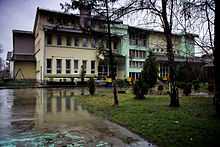
The first Albanian school in Vučitrn was opened in the fall of 1915. “Besa Kombetare” Club, led by Hasan Prishtina and Bajram Curri, sends Abdullah Hadri from Gjakova to open the first Albanian school in Vučitrn. Abdullah Hadri was a known intellectual man, who became the principal of the Albanian school in Vučitrn. In the beginning, only male classes were included in the school. More than 260 boys were registered. With the great contribution of Hasan Prishtina, the school opened the doors for the girls’ education as well. 25 girls were the first ones to be a part of the classes. Emin Efendi Hoti became the first teacher of the school. High School of Economics was opened in 21.06.1961, to fulfill the needs for professional staff of financial and accounting work. The gymnasium in Vučitrn opened in 1963/1964. In the year of 1983, the first kindergarten of the city was established. This institution included children of 1 up to 6 years. Its first principal was Feride Hyseni. The total number of poisoned students of primary and high schools of Vučitrn, by the Serbian authorities in the year of 1991, was 353. The Kosova War of 1999 left a lot of material damages and casualties in the education sector as well. From 20 primary schools in the municipality, 10 of them were completely burned and destroyed, while the others have had massive damages
Education today
Nowadays, the kindergarten has 166 children. Preschools education is organized in preschools classes (children aged 5–6) within the primary schools, on purpose to get the children ready for continuing the school. Number of children in preschools education in Vučitrn is 489. There are 47 primary schools( classes from 1-5) and secondary schools (classes from 6-9) in the municipality of Vučitrn. Organized in 548 classes, there are 12209 students who go to these schools. The number of educative personnel in this category is 852, from which 661 of them are teachers. There are 3 high schools in Vučitrn, with 4223 students on them. In these schools, there are 201 teachers. The total number of students in Vučitrn is 17087.[3] In Vučitrn, within the Kosovo Academy for Public Safety, in October 2014 will start its work the Faculty of Public Safety. In its first academic year, this Faculty will accept 65 students from all over Kosovo. The adult residents (aged 18 or older) of Vučitrn have a slightly higher education attainment than Kosovo’s average. 5671 people have no completed education, 9447 have completed primary education, 18369 have completed lower secondary education, 20049 have completed high school, 1134 have completed vocational education, 2405 have a university degree, 242 have a post graduate degree, and 29 people have a doctorate PhD.[11] Adult women residing in this municipality have a lower education attainment than men. Five percent compared to 1% of men have no formal education. In terms of the highest education level attained, 32% of women compared to 15% of men have completes primary education, 47% compared to 67% of men have completed secondary education, and 5% compared to 9% of men have a university degree.[3]
Health
The largest hospital in Vučitrn is “Sheikh Zayed” Hospital, which was reconstructed by the initiative of United Arabian Emirates, who financially helped the improvement of the building and financed the buying of the new equipment and appliances. The reconstruction started in 17.12.2001. This hospital treats patients from Vučitrn and the region.
The hospital provides services in these sectors: emergency, stomatology, vaccination, diagnostics, pharmacy and others. In the municipality of Vučitrn there are also 8 other Family Health Centers in the villages and eight Health Clinics.[12]
Culture
Vučitrn is an economic, educational, cultural and sports center. The municipality invested largely in improving the quality of life for citizens, and as a result, there are many municipality organized activities and entertainment in the city and the surrounding areas.
Religion
The Ottoman Invasion in the 14th century, converted the Albanian population into Muslims. Besides cultural monuments, Vučitrn has a lot of mosques left as a heritage from the Ottoman times. Nowadays, according to Kosovo Agency of Statistics, the biggest religions in Vučitrn are: Islamic, Orthodox and Catholic. According to 2011 Census, these are the statistics of division of the population by religion:
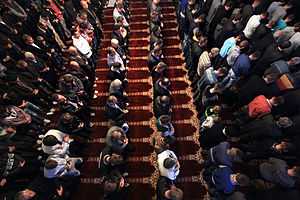
- Islamic 69.359 people
- Orthodox 386 people
- Catholic 15 people
- Others 100 people
The most ancient mosques are:
- Xhamia e Gazi Ali Beg – build in 1410 near the Public Bath (Hammam), this mosque is one of the oldest ones in Kosovo. Destroyed during the war, this mosque was rebuilt, financed by the donors.
- Xhamia Karamanli – was built in 1675 from Ogullar family. Reconstructed after the war with the help of donors because it was ruined by the Serbian army.
- Xhamia e Ҫarshise – build in 1878, in the centre of the city. During the war of Kosovo, the Serbian army destroyed it. After the war, with the initiative of United Arabian Emirates, this mosque was reconstructed. Now it is called “Sheikh Zayed” Mosque.
Except for the mosques, in Vučitrn there’s another object from Islamic tradition called Tyrbe. It is located in the city’s park and it is believed that was built nearly 200 years ago. Its shape is octagonal, and in the inside there are 6 tombs of the people who had military functions. Near the park of the city, it is located the Serb Orthodox Church of St. Elijah. The church was built in 1834 in the eastern part of the city of Vučitrn where previously had existed an old Serb medieval church.
| Xhamia e Ҫarshise |
Karamanli Mosque |
Traditional development of music
The traditional creations of folk music, dances and a significant number of traditional instruments, for centuries have been conserved with fanaticism. Years ago, in the villages of Vučitrn, were developed different kinds of music, especially ballads and legendary epic songs. Years later, the love songs, weddings songs and others started to grow. Traditional instruments that have been preserved and played until now are: lahuta, gajdja, fyelli, kavalli and defi. The most popular ones are ҫiftelia and sharkia.
During 1915-1918, with the impact of Hasan Prishtina, it was established the “First musical band” and “First association of culture and art”, which had also the section of act, music and reciters.
After the World War II, the first association of culture and art was called “Rashid Deda”, which later was renamed “Hasan Prishtina”. This association was rewarded the second place in the international event “Kacaniku 2000”. The most popular members of this association were: Ali Kufa, Azize Topojani, Shemsedin Drejta, Selvete Terstena, Xhevat Korllaku, etc.
“Hasan Prishtina” House of Culture was build in 1970. It had a great importance in the promotion of cultural life in Vučitrn. The House of Culture started its work in the these sections: traditional orchestra, dancers and entertainment orchestra.
Archive of History – was established in 3 March 1968 and it still continues its work as an independent institution.
Festivals
There is a wide range of annual activities either organized or supported by the municipality. These include:
- Gatherings of Albanian Poetesses (24–28 May) – attended by all female poets throughout the Albanian territories. This event started in 1973. In its first years of activity, it was held in the honor of 8 March – International Women Day. Female students of high schools were the only ones to participate. In 1985 the total number of participants was 53. After the war of Kosovo, this event starts gathering poetesses from all over the Albanian territories and diaspora. The most successful poetesses during years were: Miradie Ramiqi, Fehime Selimi, Xheraldina Buqinca, Hadije Jakupi, Rrezarta Duraku, Afroviti Gusho, Meri Lalaj, etc. This event takes place during 24-28 of May in the House of Culture, a tradition continuing still, and it is supported by the municipality of Vučitrn.
- Potato Day (1–10 October) is a traditional event held each year in the municipality of Vučitrn, where people from different places participate. Intellectuals, businessmen, government, facilitators from governments of different countries-ambassadors, media and other relevant people counterparts in this event.
- Regional Fair of Local Products - Local producers participate and have the opportunity to meet each other, cooperate and enhance their markets.
- Honey Day Fair - Organized in cooperation with the Beekeepers’ Association “ËMA”.
- The Independence March – young people of Vučitrn march through the city, the purpose of which is to remember the sacrifices of Kosovan people through the years, and to celebrate the Independence Day.
- The Schools’ Fair – organized by the municipality, NGOs, and schools itself, this fair promotes the skills and achievements of the students of all schools of Vučitrn.
Sport

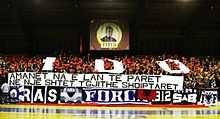
The most organized and successful sports in Vučitrn are: football, handball, basketball, volleyball, ping-pong, chess, judo, etc. The municipality now for a long time has given to Kosova’s sports a big number of qualitative sport athletes and teams, which represented Kosova in the international competitions in decent way. A huge support for every sport competition is given by Vučitrn's residents, especially by the organized group of fans, called Ultras “Forca”. “Forca” is known in the entire country as one of the most dedicated and committed ultras to Vučitrn's sport. This group of fans was established in the year of 1993 and since then they never stopped supporting every club in Vučitrn. This continuous support led them to their life motto “S’ka mu nal” (Never quit). In these days there are nearly 500 active members of this ultras, led by Samir Asllani. They show up in every football match of “Kosova” FC, handball and basketball matches, and give their enthusiastic performances and urge the teams to go for the best.
Football
F.C. Kosova Vushtrri is founded in 1922. At that time the Football Federation did not exist so the team had to play friendly matches with other teams. After the end of Second World War, the team became the member of the Football Federation where its challenges to play in Kosovar League started. In June 2012 after constant negotiations between the team and Llamkos GalvaSteel Company the successful acquisition of F.C. Kosova Vushtrri was done established by the name F.C. Llamkos Kosova.[13] The club plays the matches in “Ferki Aliu” Stadium, placed in the south of Vučitrn with a capacity of nearly 5000 seats.
The most successful players to come out of this club are Ahmed Januzi who’s currently playing for FC Vorskla Poltava in Ukrainian Premier League, and Armend Dallku who plays as a central defender for the same club as Januzi. Llamkos Kosova FC is currently in the first position in Raiffeisen Super League of Kosovo, led by its coach Ismet Munishi.
Handball
Handball Club “Kosova e Vushtrrise” was established in 1953/1954 by Fahri Buqinca. The biggest success of this club was competing in the Federative Second Division of former Yugoslavia, with Tefik Mikushnica as their coach. The best players of this club were: Jeton Terstena, Agron Shabani, Jakup Gergjaliu, Fazli Jetullahu etj. In the year of 1960 was established the handball women team KH “Kosova”.
Except “Kosova e Vushtrrise” Club, in 1974 in the village of Samadrexha was formed another male handball team called “Samadrexha”. Later, this club established the women team KH “Vicianet”. Both female and male handball teams from Vučitrn, participated in European competitions, and all of them are competing in the Super League of Kosova, while the female team of “Vushtrri” is the leader of Women Handball Super League.
Basketball
This sport first began in the year of 1955 when Fahri Buqinca brought the first basketball rims and nets. The basketball team “Llamkos” was established in 1955 by Fetah Rashica, but was only registered as a club in the Kosovo Basketball Federation in 1981. Except the senior team, there also was the junior team and the basketball school within the club. In 1987 this club reaches the final of Kosovo Super Cup. The most successful basketball player that this club gave was Ferit Zekolli who played for different basketball clubs in Kosovo, Croatia, Serbia, etc. Other players worth mentioning are Bashkim Maloku, Burim Bivolaku, Muje Ademi, Bajram Badivuku, Bekim Bivolaku, Fatmir Rashica, etc. Nowadays, the basketball male team is in the Second Division of Basketball (Liga e Pare).
Other sports
- Volleyball - was first introduced in 1946, while the first male club was formed in 1952, participating years later successfully in former Yugoslavia competitions. Qani Kaleci, Ahmet Cecelia, Raif Dallku, Xhelal Pantina, Haki Mavriqi were the most famous players of the club. Nowadays, volleyball male team “As Vushtrria” and female team “Kosova” participate and compete in First League of Volleyball in Kosovo.
- Ping Pong club “Hasan Prishtina” is one of the oldest clubs in the municipality of Vučitrn, which was founded in 1950 by Fahri Buqinca and Sakine Maxhuni. In 1961, Sakine Maxhuni as a representative of Vučitrn took the first place and became Kosovo ping pong champion. She was the first person to win a championship title in national level in any sports in Vučitrn. Xhemajl Cecelia contributed as an active player since 1960 and later became the coach of this club. In women competitions, Xhevahire Asllani was twice a runner in Kosovo’s ping pong championship.
- Chess – was one of the most famous sports in Vučitrn. Ramadan Ajvazi, Muje Ferati, Hysen Hyseni, Blerim Zabergja and Ragip Mikushnica were the first known chess masters in Vučitrn, also representing Kosovo in international chess competitions.
Sport facilities
- “Ferki Aliu” Stadium - was build in . It is located in the south part of the city. It is currently used mostly for football matches and is the home ground of KF “Llamkos Kosova” of the Kosovo Football Super League. Its capacity is approximately 5000 seats. Its infrastructure will be improved after announced investments by Ministry of Culture, Youth and Sport of Kosovo.
- “Jeton Terstena – TOTA” Sport Hall – started building in 1983. The reconstructions of the building took place in 2003. It is a very modern hall used for handball, basketball, volleyball, judo, ping-pong, boxing, etc., and other activities such as concerts, exhibitions, fairs and other indoor events.
- "Stadiumi i Gumes" – build in concrete, this stadium was used long time before the sports hall was build. Positioned near the park of the city, this stadium firstly was used for handball matches and later for futsal competitions.
Notable people
- Mara Branković (1401-1487), Serbian princess
- Gligorije Elezović (1879-1960), Serbian historian
- Snežana Mišković (known as Viktorija), (born 1958), Serbian rock artist
- Jorgovanka Tabaković (born 1960), Governor of the National Bank of Serbia
- Hasan Prishtina (1873–1933), Albanian politician, Prime Minister and nationalist
- Azem Galica (1889–1924) and Shote Galica (1895–1927), Albanian rebels
- Rahim Ademi, Croatian army general
- Ahmet Shala (b. 1961), Kosovan former minister and current ambassador
- Isa Sadriu (1963), footballer and coach
- Armend Dallku, footballer
- Ahmed Januzi, footballer
- Samir Ujkani, footballer
- Shefki Kuqi, footballer
- Njazi Kuqi, footballer
- Armend Dallku, footballer
References and Notes
- ↑ 1.0 1.1 Kosovo is the subject of a territorial dispute between the Republic of Serbia and the Republic of Kosovo. The latter declared independence on 17 February 2008, but Serbia continues to claim it as part of its own sovereign territory. Kosovo's independence has been recognised by 108 out of 193 United Nations member states.
- ↑ page=387 "Proceedings- Ecological Truth XIX International Scientific Meeting" (PDF). University of Belgrade, Technical Faculty Bor. 2011. Retrieved 2014-10-08.
- ↑ page=17, footnote 37 "Toponimija općine Klana" (PDF). KATEDRA ČAKAVSKOG SABORA DRUŠTVO ZA POVJESNICU KLANA. 2008. Retrieved 2014-10-08.
- ↑ 3.0 3.1 3.2 3.3 3.4 http://www.undp.org/content/dam/kosovo/docs/Mozaik/Kosovo_Mosaic_2012_Eng_735317.pdf
- ↑ https://kk.rks-gov.net/vushtrri/getattachment/Home/Invest-in-Vushtrri_alb.pdf.aspx
- ↑ http://www.institutigap.org/documents/71055_VUSHTRRIA.pdf
- ↑ "BINNI". Binni.biz. Retrieved 2014-07-31.
- ↑ "Ciao Berto". Ciao Berto. Retrieved 2014-07-31.
- ↑ "Llamkos". Llamkos. Retrieved 2014-07-31.
- ↑ "Products Gallery". Kotexks.com. Retrieved 2014-07-31.
- ↑ "NNT". DIJARI. Retrieved 2014-07-31.
- ↑ Educational Characteristics of Kosovo’s Population, Kosovo Agency of Statistics https://esk.rks-gov.net/eng/
- ↑ http://kk.rks-gov.net/vushtrri/getattachment/cc01b66b-6f92-4788-8a74-5b5b2fb24298/Raporti-i-punes-se-Drejtorise-per-shendetesi-dhe-m.aspx
- ↑ "Llamkos FC". Llamkos FC. Retrieved 2014-07-31.
Bibliography
- Vushtrria - Viciana me rrethine, Vučitrn 2003
- Noel Malcolm, KOSOVO A short story, 1998, London
- Fejaz Drancolli, Monumental Heritage in Kosova, 2011, Prishtine
- Evlyia Celebi, Shqiperia 350 vjet me pare